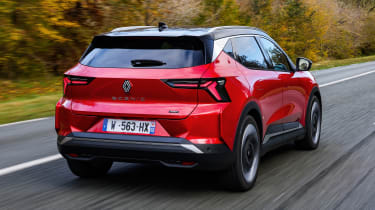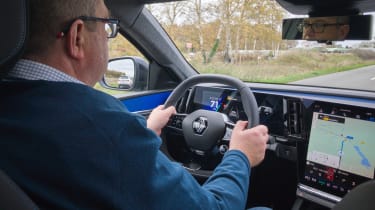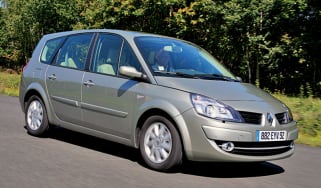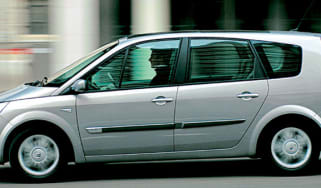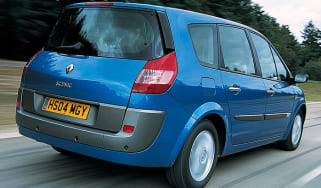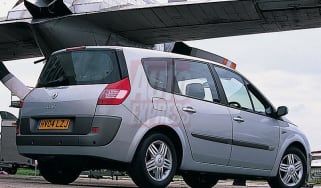New Renault Scenic 2023 review: the famous nameplate returns in style
We get behind the wheel of new all-electric Renault Scenic to see what all the fuss is about
Verdict
In isolation the Renault Scenic looks pretty expensive – a hefty step up in price compared with the cars that used to carry the badge. But it mixes well sorted driving dynamics, a spacious, practical cabin, impressive real-world range and solid tech with a price that is fully competitive in the EV landscape. And this, in turn, makes it a far more compelling family-car proposition than the Megane ever could be. The devil will be in the detail of the monthlies, admittedly, but there’s considerable potential here.
Renault might not like to admit as much in public, but the reborn Scenic is the point where the French manufacturer gets really serious about electric cars. The Zoe was a trailblazer, of course, and we’ve had the Megane more recently. But both of those cars came with a few compromises on range and packaging. The Scenic is a car designed to have no such trade-offs.
However, this Scenic is not a direct replacement for the monobox small MPV of the nineties and noughties. What we have here is, at best, a hybrid of MPV and SUV.
The front end looks pretty dramatic, complete with Renault’s latest badge patterned across the entire grille area. There’s some complex surfacing along the side and aero ‘blades’ that extend from the flanks to beyond the rear tailgate.
More reviews
Car group tests
In-depth reviews
Long-term tests
Road tests
Used car tests
The car sits on the same CMF-EV platform as the Megane, and is almost 4.5 metres long, which makes it compact in family-EV terms. It’s shorter, for example, than both the Hyundai Ioniq 5 and VW ID.4, but longer than the more conventional-looking MG4. The wheelbase measures 2.78 metres, 10cm longer than a Mégane’s – and the track is wider by a similar amount.
The UK is only being offered the larger of the two battery sizes, so we get an 87kWh (net) pack that features a revised chemistry with greater energy density than the smaller set-up shared with the Megane.
This larger battery can manage a whopping 385 miles, Renault claims – the thick end of 100 miles more than Hyundai’s big-battery, single-motor Ioniq 5. The Scenic is also fitted with a heat pump as standard, in a bid to provide increased efficiency in cooler conditions.
The peak charging speed is 150kW and Renault also says it has worked hard to ensure that the Scenic stays north of 100kW for as long as possible. As a result, the company claims you can add enough charge in half an hour of DC to take you two hours on a motorway.
That larger battery means that UK Scenics will get the CMF-EV’s more potent front-mounted motor, producing 217bhp and 300Nm of torque. And it seems pretty comfortable with a car of this size and weight – even though, at a fraction more than 1,800kg, the Scenic is towards the lighter end of the sliding scale on large family EVs. There’s enough shove for rapid progress, and the throttle is nicely modulated, so it’s an easy car to drive smoothly around town.
The chassis helps with this, too. Weight distribution is nearly 50:50 and while the underlying set-up is firm, to help the car cope with its mass, the engineers have been able to soften off the rebound. This means that, at lower speeds, the Scenic does a good job of smoothing out road scars before they can disturb cabin occupants.
Things don’t exactly fall apart on faster, bumpier roads, but it’s here where the Scenic’s size and, yes, weight start to really be felt. The steering has satisfying heft to it and it’s accurate enough, but while body control remains solid in longer corners, quicker changes of direction can unsettle it. And this is exacerbated if the road surface breaks up or the car finds mid-corner camber changes. It never reaches the point where you’d call it uncouth; it just requires a touch of patience if you’re to maintain smoothness along with speed.
You can alter the various driving modes, including a personalised setting that allows you to mix and match selected parameters. But in everyday driving we’d be tempted to leave the Scenic in Normal and play with the levels of brake-energy regeneration, a system that’s controlled by paddles mounted behind the steering wheel.
The test car we drove was described as “representative” and “95 per cent of production”, and refinement seems pretty well sorted. There’s a bit of tyre roar – not helped by chunky 20-inch alloys that you get as standard on the Esprit Alpine trim we were sampling – but you have to be pushing on a fair bit before wind noise from around the A-pillars and door mirrors becomes bothersome. It’s an easy car to hold cross-cabin conversations in – both around town and on motorways.
Inside, the fascia is dominated by Renault’s OpenR digital cockpit, which mixes a 12.3-inch digital instrument panel with a 12-inch portrait-layout infotainment system, running Android Automotive. That means Google mapping and account integration as standard. The Scenic will also use Google Maps for smarter EV route planning, a feature that extends to preconditioning the battery as you’re approaching a charging station, which maximises the potential refill speed.
There are plenty of physical controls for cabin temperature and the like, while other functions such as the heated seats and wheel have permanent shortcuts at the base of the infotainment screen.
Renault has also included a button that allows you to flick into your own configuration for the Scenic’s safety systems – allowing you, for example, to deactivate the speed-limit warnings, but retain lane-keep assistance.
The materials seem nicely chosen, and they highlight Renault’s fresh commitment to sustainability, with some parts that you frequently interact with, such as the steering wheel, covered in bio-sourced materials, and not even the option of leather.
There’s a flat floor and seating for five, although the rear cabin features a central armrest that would split two occupants. It incorporates a pair of cup-holders, stands that fold out to allow screens to be watched more comfortably, and a pair of USB-C charging sockets. Indeed, it really feels like it’s been designed to keep youngsters amused on long journeys.
The boot, meanwhile, measures 545 litres with the second row of seats in place, rising to 1,670 litres if you convert the Scenic to a two-seater. Those numbers trump the capacities of both the ID.4 and Ioniq 5, so it’s clear that Renault is targeting outright practicality as the Scenic’s USP. There’s a fair load lip, admittedly, but a planned variable-height boot floor should get around this. And at least there are a couple of shopping-bag hooks on the sides of the load bay, along with a power socket.
Renault has yet to confirm UK prices and specs; they should be detailed in time for it to start taking orders in December, with first deliveries expected by April 2024. But the indications are that the entry point, the big-battery Techno, will cost from around £40,000, with the Esprit Alpine driven here coming in at around £43,500 and the range-topping Iconic costing about £46k.
Those look competitive numbers when you consider that the Ioniq 5 starts at the same price as the mid-spec Scenic, and with a significantly smaller battery. In the long run, though, Renault’s ability to attach sensible finance packages to the car will be the defining factor for private customers, rather than list price.
| Model: | Renault Scenic E-Tech EV87 220HP |
| Price: | £44,000 (est, Esprit Alpine) |
| Powertrain: | 87kWh battery, 1x e-motor |
| Power/torque: | 217bhp/300Nm |
| Transmission: | Single-speed automatic, front-wheel drive |
| 0-62mph: | 9.7 seconds |
| Top speed: | 105mph |
| Range: | 388 miles |
| Charging: | 150kw |
| Size (L/W/H): | 4,467/1,861/1,571mm |
| On sale: | December |

